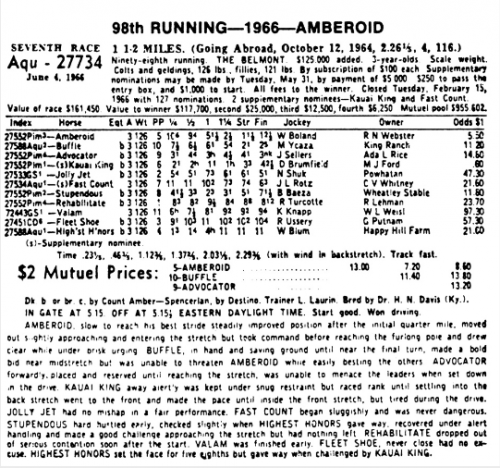The start of the 1966 Belmont Stakes (NYRA/Coglianese by permission)
The 1966 Belmont Stakes
By Maribeth Kalinich
1966 was supposed to be Kauai King’s year. The Native Dancer colt had already won the Kentucky Derby, a feat his sire had failed to do, and the Preakness Stakes, in the hoofsteps of his sire. He was the preemptive Belmont champ going into the third leg of the Spring Classics therefore a Triple Crown winner.
But Kauai King was not to wear the three-jeweled crown that year for there would be an interloper. And his name was Amberoid.
1966 was an exceptional year for 3-year-old Thoroughbreds. The likes of Graustark and Buckpasser, future Horse of the Year, would have been Kauai King’s main competition in the Belmont Stakes if not for injury and circumstance.
Foaled in Kentucky, Amberoid was named for the synthetic form of amber, fossilized tree resin used as a semi-precious gemstone in jewelry.
A dark bay resembling his prolific French-bred grandsire, Amboirix, Amberoid was bred by Dr. Horace N. Davis, Jr., a veterinarian and owner of the Thoroughbred Horse Farm, Bluegrass Height. The leggy colt with the elegant neck and head was owned by Reginald N. Webster.
Reginald Webster, born in Dublin, Ireland, became an American businessman and Thoroughbred racehorse owner after his family emigrated to the United States when he was a little boy.
He was president of the precisions parts manufacturer Standard-Thomson Corp. of Waltham, Mass., until the company’s takeover in 1974 whereas he retired.
Becoming involved in racing in 1945, Webster hired Lucien Laurin in 1947 as his conditioner. Their best success was Amberoid’s 1966 Belmont victory.
Webster also raced horses in England and Ireland. His Irish-bred colt Martial, son of Hill Gail, trained by legendary trainer Paddy Pendergast, won the 1960 2,000 Guineas at Newmarket and the Coventry Stakes at Ascot. Webster was one of only a few Americans to win both an American and British Classic.
With wins including the Matron, Acorn and Mother Goose Stakes, Webster’s filly Quill was voted 1958 Champion 2-year-old fill. Other notable horses were Traffic, National, Artfully and Pearl Necklace.
Amberoid didn’t have a front-running style, but he had a nice turn-of-foot and the heart to win rallying off the pace.
According to Equibase, as a two-year-old he placed in his first stakes at Saratoga, the Flash Stakes, August 2, 1965. Amberoid would finish third in his next two stakes, the Pimlico Futurity November 13, and the Garden State Stakes seven days later. December 1 the colt would again place in the Remsen at Aqueduct.
He carried weighted at 117 pounds on the Experimental Free Handicap for American juveniles of 1965, 9 pounds below champion Buckpasser.1
As a 3-year-old, he began with a second in the Fountain of Youth at Gulfstream March 23 followed with his first stakes win at Aqueduct in the Wood Memorial April 23. Next, he would head for the Triple Crown, Lucien Laurin’s future domain.
Laurin’s debut in the Triple Crown would be lackluster.
In the Kentucky Derby, Amberoid finished seventh, but he was only four lengths behind Kauai King, and at the start of the Derby he went to his knees coming out of the gate, all but spilling Jockey Bill Boland.
With Hall of Famer Bill Boland up Amberoid would finish seventh in the Kentucky Derby to Kauai King in a field of 15. Amberoid finished seventh, but he was only four lengths behind Kauai King, and at the start of the Derby he went to his knees coming out of the gate, all but spilling Boland.
Two weeks later, the plucky colt would run in the Preakness Stakes in a field of nine, seven of which, including Amberoid, ran in the Kentucky Derby. He was also running against the Derby champ, Kauai King. The son of Native Dancer, Kauai King fulfilled his sires one loss.
Amberoid was third in the Preakness by a length and a half. “In both of those races,” said Trainer Laurin, “we were too far back in the early running, and unless you stay up closer to a colt like Kauai King you have no chance of picking him up in the stretch.”
Amberoid wasn’t really on anyone’s radar to win the Belmont. He had won only one of his seven starts that year and had a modest three wins in 16 lifetime starts. However, the Laurin trainee went off as second choice at 5-1.
The longest of the three Classics, Laurin’s colt was conditioned well and exhibited good stamina for the course. The Belmont Stakes was held at Aqueduct that year. Laurin and Amberoid had an asset on their side: Kauai King had never started at Aqueduct, whereas Amberoid ran his finest race to date there when he won the Wood Memorial in April.
“No question about it,” said Laurin. “Amberoid loves Aqueduct. This isn’t a cuppy track, and he can take a real good hold of it. The extra distance will suit him perfectly—if he doesn’t get too far behind at the start.”4
As the start grew nearer the crowd of 56,011 at Aqueduct was sure they had a Triple Crown winner. The excitement was palpable. Would Kauai King snap the 18-year Triple Crown drought?
As expected Cortwright Wetherill’s Highest Honors who could not be rated and broke first and went to the lead. The pace would be his for as far as his speed and stamina could carry him. Stupendous and Kauai King were strategically just off the leader awaiting an opportunity. The cluster contenders who were lengths behind the leaders were attempting to gain position while saving speed for the last quarter.
Highest Honors opened up four lengths as the field headed up the backstretch, but Kauai King and Stupendous were well within range, while Advocator was a comfortable fourth and Buffle well placed in sixth position. Amberoid, saving ground all the time, was ninth.
Kauai King, although always very willing, can also be very rank, particularly at the start of a race. Usually running with his tongue hanging out and his head sharply cocked, this time his whole length was twisted nearly sideways with Brumfield all but powerless to keep him under control.
When Highest Honors folded after a mile, Brumfield had Kauai King in front—which is where Brumfield did not want to be so early in a mile-and-a-half race. As Brumfield’s charge took the lead even before the field had reached the five-eighths pole, everyone felt that he would never last, including his pilot.
The slow starter, ninth and then fifth after a mile, Amberiod rolled around the field in an amazingly courageous move that brought him just behind Kauai King at the head of the stretch. As Amberiod sailed past the favorite the crowd instinctively knew the race was his. Only Buffle, ridden by Manuel Ycaza, gave a game challenge over the last furlong, but it was not nearly enough. The grandson of Amboirix and Count Fleet had stamped his name in the history books.
Kauai would be denied his Belmont and Triple Crown finishing fourth beaten by eight lengths behind Buffle. Brumfield had no real excuse. “We fired—and fell back,” he said.4
When the dirt settled on the 98th Belmont Stakes it would be Reginald N. Webster who raised the substantial August Belmont Trophy in victory. That very trophy is what brought this writer to want to tell Amberoid’s story as the exquisite piece of silversmithing was featured on an episode of Antiques Roadshow along with his Wood Memorial Trophy.
Click here to see Amberoid’s horse racing trophies on Antiques roadshow Wood Memorial Trophy and Belmont Owner’s Trophy.
One of the least surprised by Amberoid’s victory was Kauai King’s owner, Mike Ford. Still remaining the unpretentious everyman, Ford was quoted as saying “I’ve been telling Lucien Laurin all along that his is the one horse we’ve been most scared of during these Triple Crown races.”
The final time of the race was 2:29.60.
Still a contender as a four-year-old, Amberoid would win the Camden Handicap at Garden State Park in May and place in the Gulfstream Park Handicap in March, Grey Lag Handicap at Aqueduct in April and later in July he would place in the Amory L. Haskell Handicap at Monmouth.
Amberoid completed his career with a record of 33 starts, seven wins, ten seconds and five thirds with earnings of $491,716. In 2022 money that translates to $4,386,106.
When his racing career was over, Amberoid stood at stud in the United States from 1969 to 1973, after which he stood in Japan.
Kauai King would also end up standing in Japan. He proved less than successful as a sire. Near the end of 1971, he was shipped to stand at stud in England. He remained there until 1973 before being sent to a breeding farm in Japan where he died on January 24, 1989.
Amberoid sired 54 winners (62.7%) and three stakes winners (3.5%) from 86 named foals according to Jockey Club records. Records from his service in Japan may be incomplete. Amberoid’s best runner was Midnight Madrigal, Puerto Rico’s champion imported 3-year-old filly of 1973.1
Sired by 1961 Narragansett Special Handicap winner Count Amber, Amberoid is outcrossed through five generations. He is a full brother to juvenile stakes winner My Pal Houston.1
Spencerian, the dam of Amberoid, is a full sister to the stakes-winning hurdler Pistol W. and is by the Beau Pere horse Destino, a half-brother to 1944 Horse of the Year Twilight Tear who placed in five of his seven starts but failed to win. She was produced from Script (by Bimelech), a stakes-placed half-sister to 1959 Man o’ War Handicap winner Dotted Line (by Princequillo). Dotted Line, in turn, is the dam of stakes winners Draft Card and Gentleman’s Word (both by Gallant Man) and is the third dam of Grade 3 winner Ruben’s Art.1
Script and Dotted Line were produced from the Brazado mare Inscribe, a half-sister to multiple stakes winner Free Stride (by Depth Charge). A daughter of 1938 American champion 2-year-old filly Inscoelda (by Insco), Inscribe is also a half-sister to stakes-placed Include (by Equestrian), dam of multiple stakes winners Ring of Kerry (by Destino) and Inclusive (by Curandero), and to Present Tense (by Depth Charge), dam of juvenile stakes winner Cassie Mac (by Poona II).1
Amberoid died in Japan on June 30, 1985.
His owner, Reginald Webster, a member of The Jockey Club and president of The Thoroughbred Owners and Breeders Association, had died two years earlier in Palm Beach, Fla., at the age of 85.
The Maestro
Lucien Laurin would go into the history books under several incarnations beginning in 1929 in Joliette, Quebec as a jockey. After riding 161 winners and battling weight problems he began his career as a trainer in 1942. He soon after joined the stable of Reginald Webster that led him to Amberoid in 1966.
Having once retired, Laurin came back to training in 1971 to join the team at the Meadow. And the rest is written in legend.
Laurin would win and Eclipse Award for Outstanding Trainer and join many of the characters in this story as inductees in the Horse Racing Hall of Fame.
The storied trainer’s wins included 29 stakes including four Wood Memorial Stakes, a Preakness, two Kentucky Derby wins and three Belmont Stakes victories.
Laurin died in 2000 at a Miami hospital in Key Largo, Florida. He always said the same phrase to Turcotte as he trotted his charges to the track: “Bonne Chance.” French for good luck. And luck is exactly what Laurin brought to the Sport of Kings.
________________________
1: A portion of this story is reprinted by permission from American Classic Pedigrees, Avalyn Hunter.
Amberoid is profiled in Chapter 9 of Avalyn Hunter’s American Classic Pedigrees 1914-2002 (2003, Eclipse Press).
Sources: American Classic Pedigrees, Claiborne Farm, Equibase, Filmore County Journal, Legacy.com,





